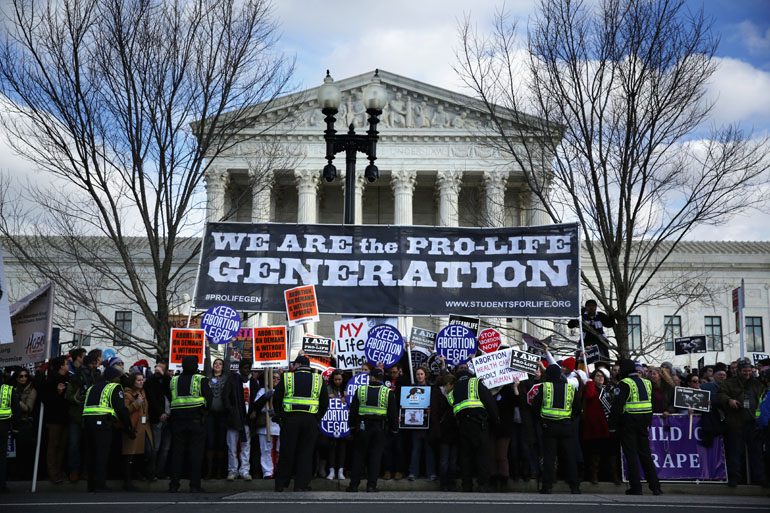The sudden death of Associate Justice Antonin Scalia has complicated the fate of many major cases before the Supreme Court this term. But few issues face as much turmoil going forward as women’s reproductive rights.
In March the court is scheduled to hear two separate cases; one on abortion and one on contraceptive insurance coverage. And the absence of Scalia means predictions of what may be the state of the law come the end of the court’s term this June are being turned, if not on their heads, at least sideways.
The abortion case, which originated in Texas, is considered the more significant of the two. Whole Women’s Health v Hellerstedt asks whether the state’s law imposing a series of restrictions on abortion clinics amounts to an “undue burden” on a woman’s right to have the procedure. With only part of the law in effect, about half of the state’s 40 abortion clinics have closed. If the rest of the law is allowed to take full effect, abortion providers estimate that only around 10 would remain open.
The contraceptive case, Zubik v Burwell, is actually seven separate cases that have been bundled together. All the plaintiffs are religious-affiliated institutions that claim the Obama administration’s “accommodation” to allow them not to offer contraceptive coverage as part of their health plans still interferes with their religious freedom.
The administration’s rules specify that religious hospitals or schools do not have to “contract, arrange, pay, or refer a person for contraceptive coverage.” But it does require those entities to tell the federal government who its insurer is, so the government may make arrangements for the coverage to be provided. That, argue the plaintiffs, makes them “complicit in sin” through the act of providing coverage.
Prior to Scalia’s death, it was considered likely that the court would uphold the Texas law, thus giving the nod not just to Texas, but to a broad array of state laws to scale back abortion access by, among other things, requiring doctors who perform abortions to have admitting privileges at a nearby hospital and requiring abortion clinics to meet the same health and safety standards as “ambulatory surgical centers” that do much more complicated procedures.
Predictions were not as clear in the contraceptive case. In all the cases before the high court, lower courts found that the administration’s requirements did not violate the religious rights of the entities in question. But in other cases appeals court judges have found for the religious entities.
Now, however, it’s considered possible, if not likely, that both cases could end in a 4-4 tie. And that would be a mess, say those on both sides.
“There’s no doubt it would be a muddle,” said Kyle Duncan, an attorney in private practice who has represented states seeking to impose abortion restrictions and religious organizations objecting to the contraceptive coverage rules.
The result of a tie vote at the Supreme Court is that the lower court ruling stands but that lower court ruling does not create a national precedent. That precedent would apply only in the geographic “circuit” where the case was brought.
But while that would allow the Texas law to take effect, it is unclear what it would mean for the rest of the Fifth Circuit, which includes Mississippi and Louisiana. That’s because a different panel from the same appeals court struck down a Mississippi law on hospital admitting privileges in 2014.
The two laws are not identical, but “you have some tension there” between some members of the same appeals court, said Duncan, “that the Fifth Circuit might have to reconcile,” by rehearing one of the cases with all of the appeals court judges participating, rather than a three-judge panel.
In the contraceptive case, the federal rules are identical. But a tie could mean those rules would apply differently depending on how each circuit’s appeals court ruled.
That’s not ideal, says David Cohen, a professor at Drexel University’s law school. “The Supreme Court normally tries to resolve circuit splits because they don’t want federal laws interpreted differently in different parts of the country,” he said.
In both the contraceptive and abortion cases, if the Supreme Court deadlocks, they could hold the case over until the next term and re-hear it then. There’s even precedent for that on reproductive health: Roe v Wade itself was heard twice; once in December 1971 (when there were two vacancies on the court), then again in October 1972.
But it is far from clear whether there will even be a replacement for Scalia when the court’s next term begins this October. “The idea of getting a ninth justice anytime soon seems unlikely,” said Duncan.
On that he and Cohen agree. “I fear we’re not going to have a justice for 15 or 16 months. If we’re lucky,” he said.








